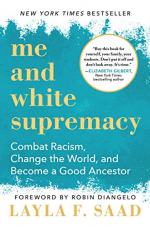
|
| Name: _________________________ | Period: ___________________ |
This test consists of 15 multiple choice questions and 5 short answer questions.
Multiple Choice Questions
1. At the end of Week 1, Saad reiterates that the work of the book looks for which of the following?
(a) Creating truth.
(b) Handling truth.
(c) Manipulating truth.
(d) Denying truth.
2. Saad uses the term “unpacking” frequently in the book. Which of the following meanings does it carry in the book?
(a) Emptying out for relief.
(b) Moving in and settling down.
(c) Taking things out of a bag or case.
(d) Bringing out small parts for examination.
3. In addition to white, which of the following identities does Saad note carry privilege?
(a) Homosexual.
(b) Able-bodied.
(c) Texan.
(d) Female.
4. References to “the extreme right” and “right-wing ideology” (97) offer examples of which of the following?
(a) Metonymy.
(b) Analogy.
(c) Simile.
(d) Conceit.
5. “White privilege” and “unconscious bias” are described in the book as being what for “white supremacy"?
(a) Eponyms.
(b) Antonyms.
(c) Homophones.
(d) Euphemisms.
6. Saad cites which of the following questions as being asked in tone policing herself?
(a) Am I coming across as too angry?
(b) Am I coming across as too beautiful?
(c) Am I coming across as too happy
(d) Am I coming across as too sad?
7. What does Saad list as her own reasons to continue the work outlined in the book?
(a) Commitment to truth, justice, and the American way.
(b) Commitment to love, truth, and being a good ancestor.
(c) Commitment to finding a good time.
(d) Commitment to overthrowing British society.
8. What tips does Saad recommend for doing the work outlined in the book?
(a) Keeping on keeping on.
(b) Keeping it real.
(c) Keeping a journal.
(d) Keeping a pet.
9. When were the updated “doll tests” conducted?
(a) The 1990s.
(b) The 1980s.
(c) The 2010s.
(d) The 2000s.
10. What meaning does the term “white fragility” carry?
(a) Enthusiasm for discussions of race by white people.
(b) Breakability of bones in white people.
(c) Intolerance of discussions of race by white people.
(d) Tolerance of discussions of race by white people.
11. Saad claims residence in which country?
(a) Bahrain.
(b) Yemen.
(c) Qatar.
(d) Kuwait.
12. Which of the following does Saad include among the purposes of the work outlined in the book?
(a) Being celebrated.
(b) Getting stuck.
(c) Seeing truth.
(d) Feeling shame.
13. The phrase “real, raw, ugly truths” (36) offers an example of which of the following?
(a) Alliteration.
(b) Anaphora.
(c) Rhyme.
(d) Chiasmus.
14. The acronym BIPOC means which of the following in the book?
(a) Broken, Injured, and People of Contempt.
(b) Black, Indigenous, and People of Color.
(c) Battered, Indigent, and People of Concern.
(d) Birds, Insects, and Plants of Commendation.
15. Saad quotes Claudia Rankine as writing “For Serena, the daily diminishment is a low flame, a constant drip" (71). The sentence offers examples of which of the following?
(a) Simile.
(b) Analogy.
(c) Conceit.
(d) Metaphor.
Short Answer Questions
1. The term “Herculean” carries what meaning?
2. Which of the following does Saad list as an example of white silence?
3. What does Saad identify as a danger of white exceptionalism to doing the work outlined in the book?
4. The term “postracial” has what meaning?
5. The term “African American Vernacular English” carries what meaning?
|
This section contains 607 words (approx. 3 pages at 300 words per page) |

|




